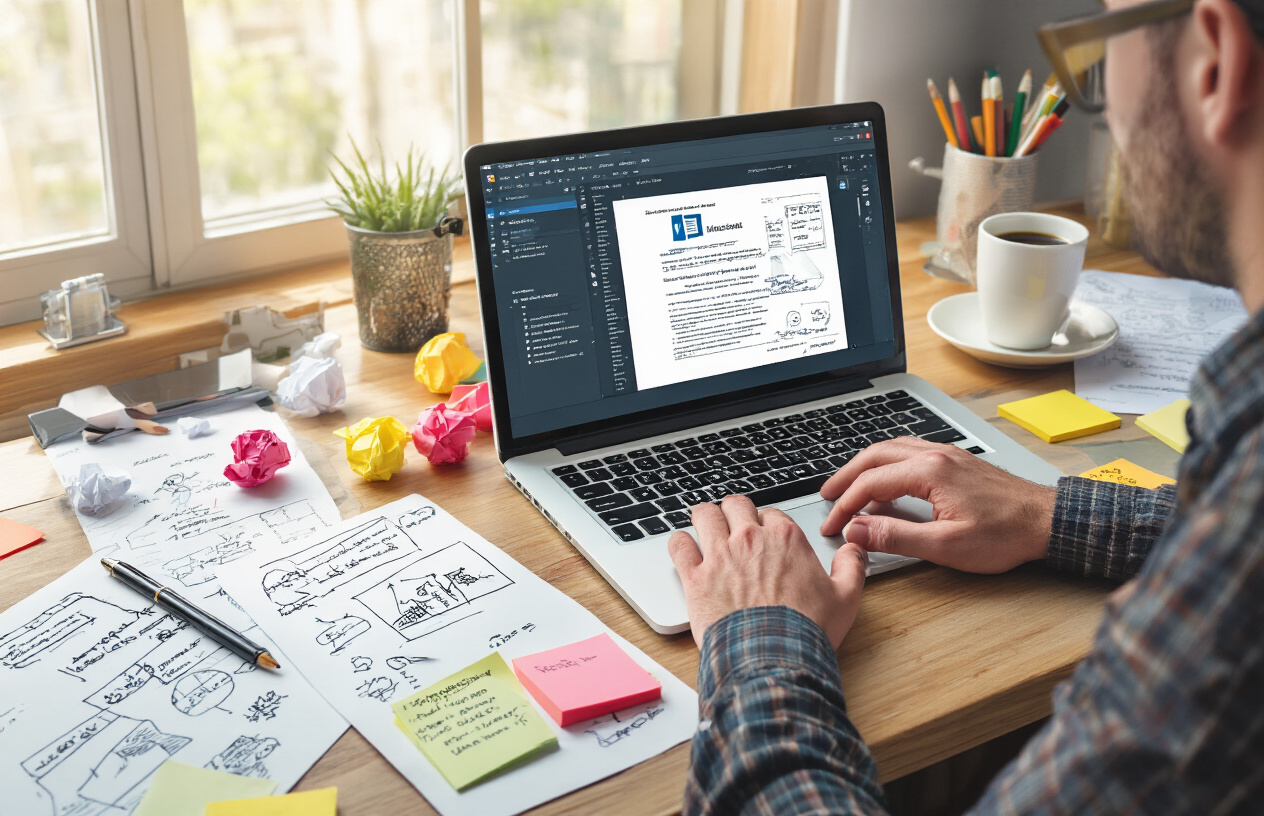Turning scattered thoughts into polished content doesn’t have to feel overwhelming. This guide shows writers, students, content creators, and professionals how to develop ideas in Word using proven Microsoft Word productivity tips that streamline your entire creative process.
- Set Up Your Word Environment for Maximum Productivity
- Configure Essential Writing Tools and Templates
- Customize Ribbon and Quick Access Toolbar
- Enable Automatic Save and Backup Features
- Optimize Page Layout and Formatting Options
- Capture and Organize Your Initial Concept
- Use Word’s brainstorming features effectively
- Create mind maps with SmartArt graphics
- Structure ideas using outline view mode
- Transform Raw Ideas into Structured Content
- Apply heading styles for logical hierarchy
- Use comments and track changes for iteration
- Implement Word’s research tools for fact-checking
- Organize sections with navigation pane
- Create cross-references and internal links
- Enhance Your Ideas with Visual Elements
- Insert relevant images and graphics seamlessly
- Create professional charts and tables
- Design custom diagrams with drawing tools
- Refine and Perfect Your Developed Concept
Many people struggle with idea development because they jump straight into writing without setting up their workspace or organizing their thoughts first. Word offers powerful tools for structured writing that most users never discover, from brainstorming templates to advanced formatting options that keep your ideas flowing smoothly.
We’ll walk through setting up your Word environment for maximum focus and efficiency. You’ll learn practical Word brainstorming techniques to capture and organize your initial concepts, plus discover how to transform those raw ideas into well-structured content. Finally, we’ll explore ways to enhance your work with visual elements and refine everything into a polished final product.
By the end, you’ll have a complete Word writing workflow that turns idea development from a frustrating guessing game into a systematic process you can repeat every time inspiration strikes.
Set Up Your Word Environment for Maximum Productivity

Configure Essential Writing Tools and Templates
Your journey to develop ideas in word starts with creating the perfect workspace. Microsoft Word offers powerful built-in templates specifically designed for brainstorming and idea development. Access these through File > New and search for “brainstorming” or “planning” templates. These templates provide structured frameworks that help organize your thoughts from the initial spark to fully developed concepts.
Create custom templates that match your unique idea development process. Set up documents with dedicated sections for mind maps, bullet points, and expanded thoughts. Save these as personal templates by going to File > Save As > Word Template. This simple step transforms your microsoft word productivity tips game by eliminating setup time for future projects.
Install essential add-ins like MindMeister or Lucidchart for Word to enhance your brainstorming capabilities. These tools integrate seamlessly with your word writing workflow and provide visual thinking support directly within your document.
Customize Ribbon and Quick Access Toolbar
Transform your Word interface into a content creation with word powerhouse by customizing the ribbon. Right-click on the ribbon and select “Customize the Ribbon” to add frequently used commands for idea development. Add tools like Insert Comment, Track Changes, and Word Count to your main ribbon tabs.
The Quick Access Toolbar becomes your command center for rapid idea capture. Add these essential commands:
- Quick Save (Ctrl+S shortcut)
- Undo/Redo for experimental thinking
- New Comment for self-reflection notes
- Find & Replace for concept refinement
- Word Count to track progress
Position frequently used formatting tools like Bold, Italic, and Highlight in your Quick Access Toolbar. This setup reduces mouse clicks and keeps your creative flow uninterrupted while you organize thoughts in word.
Enable Automatic Save and Backup Features
Nothing destroys creative momentum like losing your work. Enable AutoSave through File > Options > Save. Set AutoSave to every 1-2 minutes for maximum protection of your developing ideas. This feature becomes crucial when you’re deep in the word brainstorming techniques zone and forget about manual saving.
Configure automatic backup by enabling “Always create backup copy” in the Save options. This creates .wbk files that serve as safety nets for your structured writing in word projects. Store these backups in a dedicated folder on your cloud storage for additional security.
Set up version history by saving your documents to OneDrive or SharePoint. This allows you to track how your ideas evolve over time and recover previous versions if you need to backtrack on your development process.
Optimize Page Layout and Formatting Options
Design your document layout to support creative thinking. Switch to Draft view (View > Draft) for distraction-free writing when capturing initial thoughts. This view eliminates visual clutter and helps you focus purely on content generation.
Create a dual-pane setup using View > Split to work with research materials and your main document simultaneously. This layout proves invaluable when developing ideas that require reference materials or when comparing different concept variations.
Establish consistent formatting styles that support your thinking process:
| Style Type | Purpose | Recommended Format |
|---|---|---|
| Heading 1 | Main concept | Bold, 16pt, colored |
| Heading 2 | Sub-ideas | Bold, 14pt |
| Body Text | Detailed thoughts | 12pt, 1.5 line spacing |
| Comments | Side notes | Italic, smaller font |
Set paragraph spacing to 1.5 or double-spacing to leave room for handwritten notes during review sessions. This physical space encourages deeper thinking and allows for easy annotation of your digital ideas.
Configure your ruler and gridlines (View > Show > Ruler/Gridlines) to help organize visual elements and maintain consistent spacing throughout your document. This structure supports the microsoft word for writers experience by creating a professional, organized appearance that reflects clear thinking.
Capture and Organize Your Initial Concept

Use Word’s brainstorming features effectively
Word’s built-in brainstorming tools can transform scattered thoughts into organized concepts. The Comments feature works brilliantly for quick idea capture – simply highlight any text and add a comment with related thoughts, questions, or inspiration. This word brainstorming technique keeps your creative flow intact while building a searchable repository of ideas.
The Research tool (found under References) connects your initial concepts to external sources instantly. Type keywords related to your idea, and Word pulls relevant information from encyclopedias, dictionaries, and thesauruses. This immediate access to supporting material helps develop ideas in word more thoroughly than traditional brainstorming methods.
Track Changes becomes a powerful brainstorming companion when you enable it before writing. Every deletion, addition, or modification gets preserved, creating a visual timeline of how your idea evolved. You can review rejected concepts later and often find gems worth revisiting.
Create mind maps with SmartArt graphics
SmartArt transforms abstract thinking into visual representations that reveal connections between ideas. Navigate to Insert > SmartArt and select from hierarchical, process, or relationship diagrams that match your thinking style. The Hierarchy category works perfectly for breaking down complex concepts into manageable components.
Start with a central idea in the top box, then add branches for supporting themes. Each branch can expand into sub-branches, creating a comprehensive visual map of your concept. Microsoft Word productivity tips include using different colors for each major branch – this visual coding helps your brain process relationships more effectively.
The Radial diagrams work exceptionally well for exploring how multiple ideas connect to a central theme. Place your core concept in the center circle, then add related ideas in surrounding circles. Word automatically adjusts spacing and formatting, letting you focus purely on content connections.
Structure ideas using outline view mode
Outline View revolutionizes how you organize thoughts in word by providing a collapsible, hierarchical structure for complex ideas. Switch to Outline View through the View tab, and your document transforms into a dynamic organizational system where headings become expandable sections.
Create your main topics as Level 1 headings, then use Tab to demote supporting ideas to Level 2, 3, or deeper levels. The beauty lies in the collapse function – click the minus sign next to any heading to hide its content, giving you a bird’s-eye view of your idea development process.
| Outline Level | Best Used For | Keyboard Shortcut |
|---|---|---|
| Level 1 | Main concepts | Ctrl + Alt + 1 |
| Level 2 | Supporting themes | Ctrl + Alt + 2 |
| Level 3 | Details and examples | Ctrl + Alt + 3 |
The Promote and Demote buttons in the Outline tab let you restructure ideas effortlessly. Drag headings up or down to reorder sections, and Word automatically adjusts subordinate content. This flexibility makes outline view perfect for structured writing in word projects where ideas need constant refinement and reorganization.
Transform Raw Ideas into Structured Content

Apply heading styles for logical hierarchy
Your scattered thoughts need structure to become compelling content. Word’s heading styles transform chaotic ideas into organized arguments that readers can follow effortlessly. Start with Heading 1 for your main topic, then use Heading 2 for major sections and Heading 3 for supporting points.
The beauty of structured writing in word lies in consistency. When you apply heading styles properly, your word document organization becomes automatic. Your main argument sits at the top level, supporting evidence fills the second tier, and specific examples populate the third level. This hierarchy guides readers through your logic step by step.
To develop ideas in word effectively, select text and choose from the Styles ribbon rather than manually formatting. This approach ensures uniform appearance and enables Word’s navigation features. Your heading structure also creates an automatic table of contents, making complex documents instantly navigable.
Use comments and track changes for iteration
Raw ideas rarely emerge perfect. Comments and track changes turn Word into your personal editing studio where ideas evolve naturally. Insert comments to capture fleeting thoughts, ask yourself questions, or note areas needing expansion. These digital sticky notes preserve your creative process without cluttering the main text.
Track Changes reveals your idea development process in action. Every revision becomes visible, letting you see how concepts mature from rough sketches to polished arguments. This feature proves invaluable when collaborating or when you need to backtrack to earlier versions of an idea.
The Review tab houses these powerful tools. Comments appear in the margin, while tracked changes highlight additions, deletions, and modifications. You can accept or reject changes individually, maintaining complete control over your content’s evolution.
Implement Word’s research tools for fact-checking
Strong ideas need solid foundations. Word’s built-in research tools help verify facts without leaving your document. The Smart Lookup feature provides instant access to web definitions, explanations, and related topics. Right-click any term to explore its meaning and context.
Microsoft word productivity tips often overlook the Research pane, but it’s a goldmine for writers. Access it through the Review tab to search encyclopedias, dictionaries, and online resources. This tool helps strengthen arguments with credible information while maintaining your writing flow.
The Researcher feature takes fact-checking further by finding relevant sources and automatically formatting citations. Simply click Insert > Researcher, enter your topic, and browse curated results from reliable sources. This streamlines the verification process that transforms good ideas into great content.
Organize sections with navigation pane
The Navigation Pane turns your document into an interactive map of your ideas. View it by selecting View > Navigation Pane. This feature displays your heading structure as a clickable outline, making large documents manageable.
Drag and drop headings in the Navigation Pane to reorganize entire sections instantly. This flexibility lets you experiment with different arrangements until your argument flows perfectly. You can also search for specific terms and jump directly to relevant sections.
The Navigation Pane shows three views: headings, pages, and results. The headings view provides your document’s skeleton, pages view offers thumbnail navigation, and results view highlights search terms. This triple perspective helps you see both forest and trees as you organize thoughts in word.
Create cross-references and internal links
Professional documents need internal connections that guide readers through complex ideas. Cross-references automatically update when you move content, ensuring your internal links never break. Insert these through References > Cross-reference to link to headings, figures, or tables.
Internal links create a web of connections within your document. Use bookmarks to mark important sections, then link to them from anywhere in your text. This technique helps readers jump between related concepts without losing their place.
Content creation with word becomes more sophisticated when you master these linking tools. Numbered lists, figure captions, and section references all become dynamic elements that adapt as your document grows. Your ideas become interconnected, creating a cohesive argument that readers can navigate intuitively.
These linking features transform static documents into interactive experiences. Readers can explore your ideas non-linearly, following their interests while maintaining connection to your main argument. This approach respects different learning styles and keeps readers engaged with your content.
Enhance Your Ideas with Visual Elements

Insert relevant images and graphics seamlessly
Adding visual elements to your Word document transforms abstract ideas into compelling, memorable content. When you develop ideas in word, incorporating images and graphics helps readers connect with your concepts on a deeper level. Start by positioning your cursor where you want to insert an image, then navigate to Insert > Pictures. Choose from your device, stock images, or online sources to find visuals that perfectly complement your content.
The key to professional-looking documents lies in proper image formatting. Right-click any inserted image to access text wrapping options – “Square” or “Tight” wrapping allows text to flow naturally around your visuals. Resize images by dragging corner handles while holding Shift to maintain proportions. Use the Picture Format tab to adjust brightness, contrast, and apply artistic effects that match your document’s tone.
Word’s stock image library offers thousands of high-quality photos and illustrations without copyright concerns. Search using specific keywords related to your topic, and filter by style, color, or orientation. For icons and simple graphics, explore the Icons feature under Insert > Icons, which provides scalable vector graphics perfect for highlighting key points.
Smart placement makes all the difference. Position images near relevant text sections, use consistent sizing throughout your document, and maintain adequate white space around visuals. This approach keeps readers engaged while reinforcing your written ideas with powerful visual storytelling.
Create professional charts and tables
Charts and tables turn complex data into digestible visual information that strengthens your arguments and clarifies relationships between concepts. Word’s integrated charting tools make it simple to create compelling data visualizations without leaving your document. Click Insert > Chart to choose from column, line, pie, bar, and specialized chart types.
The chart creation process begins with entering your data in the accompanying Excel spreadsheet that opens automatically. Replace the sample data with your own numbers, labels, and categories. Watch as your chart updates in real-time, providing immediate feedback on how your information will appear. Close the spreadsheet when finished, and your chart becomes a fully integrated part of your Word document.
Customization options abound for making charts that match your document’s aesthetic. Click on any chart element – titles, legends, data labels, or axes – to modify colors, fonts, and positioning. The Chart Design tab offers pre-built styles and color schemes that instantly transform basic charts into professional-grade visuals.
Tables excel at organizing comparative information and structured data. Insert > Table lets you specify exact dimensions or draw custom table shapes. Use the table design tools to apply consistent formatting, alternate row colors, and professional borders. For complex data sets, consider using Excel tables embedded in Word for advanced calculation capabilities while maintaining seamless integration with your word document organization.
Design custom diagrams with drawing tools
Word’s drawing tools unlock creative possibilities for illustrating complex processes, relationships, and abstract concepts. The Insert > Shapes menu provides rectangles, circles, arrows, callouts, and specialized symbols for building custom diagrams from scratch. These tools prove invaluable when standard images can’t capture your specific ideas.
Start with basic shapes and build complexity gradually. Hold Shift while drawing to create perfect squares and circles. Use the alignment guides that appear automatically to ensure precise positioning relative to other elements. Group related shapes by selecting multiple objects and right-clicking to choose “Group” – this keeps diagram components together when moving or resizing.
SmartArt takes diagramming to the next level with pre-designed templates for organizational charts, process flows, hierarchies, and relationship maps. These templates automatically adjust spacing, colors, and proportions as you add or remove elements. Access SmartArt through Insert > SmartArt, then browse categories to find layouts that match your communication needs.
The Format tab becomes your creative control center when working with shapes and SmartArt. Experiment with fill colors, outline styles, shadow effects, and 3D formatting. Text boxes integrated into shapes accept formatting just like regular document text, supporting your structured writing in word approach.
Color coordination across all visual elements creates cohesive, professional-looking diagrams. Use your document’s theme colors or create custom color schemes that reinforce your brand or topic. Consistent styling across shapes, text, and effects transforms simple drawings into polished visual communications that effectively support your idea development process.
Refine and Perfect Your Developed Concept

Utilize advanced spell check and grammar tools
Word’s built-in spell check and grammar tools go far beyond the basic red and green squiggles you might remember. The Editor feature provides comprehensive writing assistance that helps polish your ideas to professional standards. Press F7 or click the Editor tab to access detailed suggestions for clarity, conciseness, and readability.
The tool analyzes your writing style and offers specific recommendations. It catches passive voice overuse, suggests stronger word choices, and identifies sentences that might confuse readers. For idea development process work, this feedback proves invaluable because it helps you express complex thoughts more clearly.
Set up custom dictionaries for specialized terminology related to your field. This prevents the spell checker from flagging industry-specific words while still catching genuine errors. The learning feature adapts to your writing style over time, making suggestions more relevant to your voice.
Grammar tools also check for consistency in terminology throughout your document. When developing ideas in word, maintaining consistent language strengthens your argument and keeps readers engaged.
Apply consistent formatting with styles
Styles transform messy drafts into polished documents without manual formatting headaches. Create custom styles for different types of content – main ideas, supporting details, quotes, and examples. This structured writing in word approach keeps your focus on content rather than appearance.
The Styles gallery lets you apply formatting instantly. Click once to format a heading, another click for body text. This consistency makes your ideas easier to follow and more professional looking.
Custom styles save enormous time during revision. Change a style definition once, and every paragraph using that style updates automatically throughout your document. Need all your main points in blue instead of black? One click changes everything.
| Style Type | Purpose | Key Settings |
|---|---|---|
| Heading 1 | Main sections | Bold, 16pt, space after |
| Heading 2 | Subsections | Bold, 14pt, left indent |
| Body Text | Regular content | 12pt, justified, line spacing |
| Quote | Citations | Italic, indented, smaller font |
Building a style library specific to your content creation with word needs speeds up future projects. Save frequently used styles as a template for consistent formatting across all your documents.
Generate automatic table of contents and indexes
Word automatically generates navigation elements that make complex ideas accessible to readers. Insert a table of contents that updates as you modify headings and structure. This feature proves especially valuable when your ideas evolve during development.
The automatic table of contents reflects your document’s logical flow. If sections seem out of place in the TOC, it often indicates structural issues in your argument. Use this feedback to reorganize ideas more effectively.
Create indexes to highlight key concepts throughout your document. Mark important terms as index entries, and Word compiles them alphabetically with page numbers. This feature works particularly well for research-heavy projects where readers need to locate specific information quickly.
Both features update automatically when you add, remove, or modify content. Right-click and select “Update Field” to refresh the table of contents after making changes. This dynamic updating means you can focus on developing ideas without worrying about manually tracking page numbers or section references.
Cross-references link related sections within your document. Instead of writing “see page 15,” insert a cross-reference that updates automatically if content moves. This maintains accuracy throughout the revision process.
Implement version control for multiple drafts
Version control prevents the nightmare of losing important ideas or accidentally overwriting good content. Word’s Track Changes feature records every modification, showing exactly what changed between drafts. Enable this before sharing documents with collaborators or making major revisions.
Save major revisions as separate files with clear naming conventions: “ProjectName_v1_Draft,” “ProjectName_v2_Revised,” “ProjectName_v3_Final.” Include dates in filenames for complex projects with multiple revision cycles.
The Compare Documents feature highlights differences between versions side-by-side. This visualization helps you see how ideas evolved and recover accidentally deleted sections. When microsoft word productivity tips include version management, you’ll never lose track of your best ideas again.
Comments preserve reasoning behind changes without cluttering the main text. Add notes explaining why you made specific revisions or mark areas needing further development. These annotations prove invaluable when returning to projects after breaks.
AutoSave and OneDrive integration provide additional protection. Your work saves automatically to the cloud, creating a backup history you can access from any device. This seamless word writing workflow ensures your developed ideas remain safe and accessible throughout the creative process.

Word gives you everything you need to turn that spark of inspiration into something amazing. From setting up your workspace just right to organizing your thoughts, structuring your content, adding visuals, and polishing every detail – you’ve got all the tools at your fingertips. The magic happens when you stop treating Word like just a typing program and start using it as your complete idea development studio.
Don’t let another brilliant idea slip away because you didn’t know how to capture and develop it properly. Open up Word today and start experimenting with these techniques. Your future self will thank you when that random thought becomes your next big project, presentation, or breakthrough. The best ideas are the ones you actually do something with, and now you know exactly how to make that happen.




